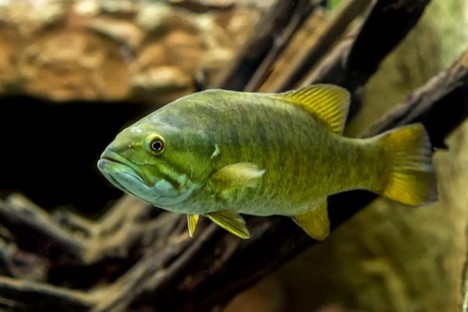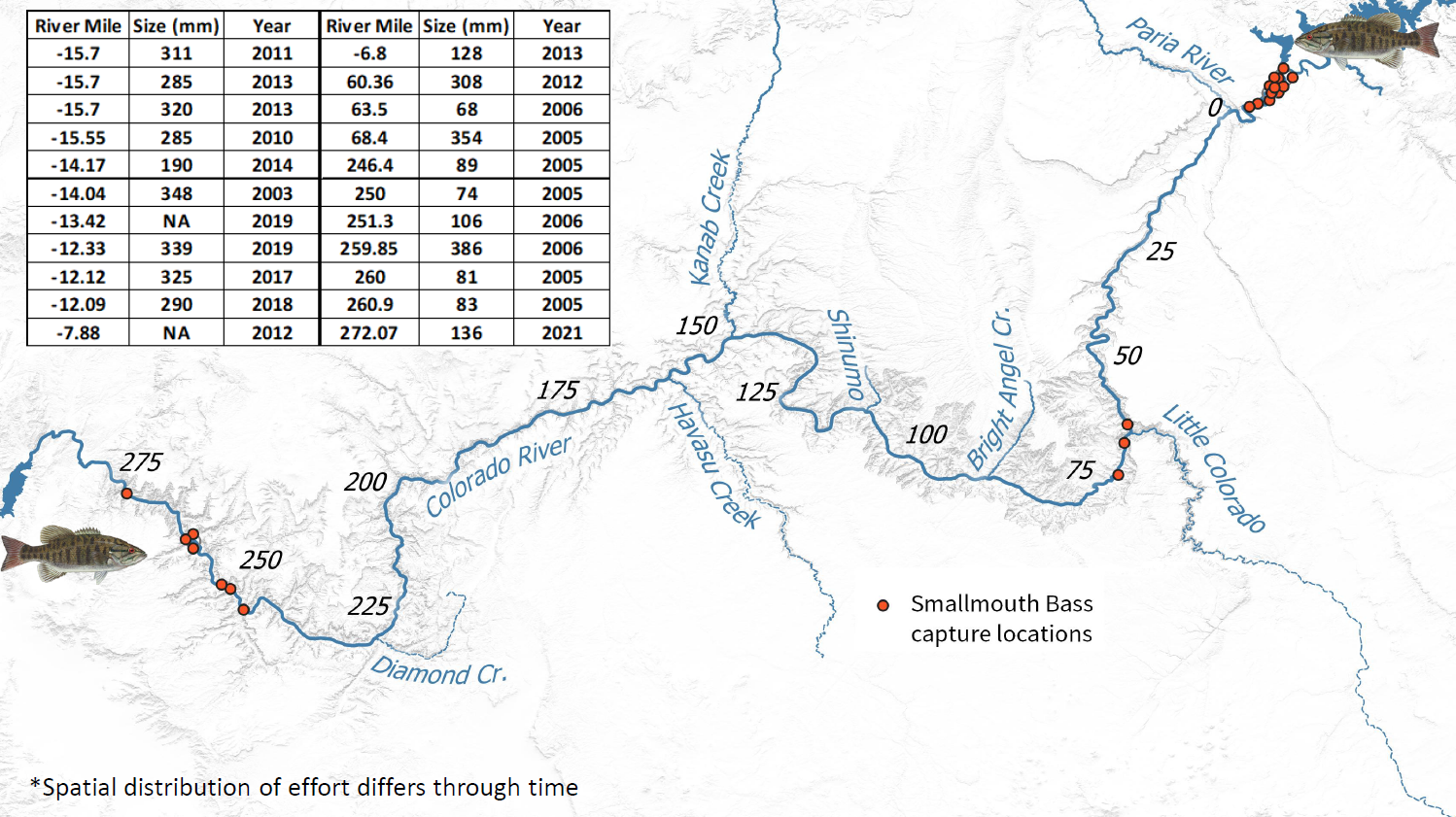|
Description: Smallmouth bass are a nonnative fish that was introduced into Arizona in 1921. They are native to the upper Mississippi River basin. These bass are most often bronze to brownish in color, with dark vertical bars on the sides.
In contrast to the largemouth bass, the upper jaw does not extend beyond the rear margin of
the eye. The eye is reddish in color and there is a shallow notch in the dorsal fin. The soft
dorsal fin has 13 to 15 rays. Length can vary between 12 and 22 inches, and smallmouth
bass can weigh between 8 ounces and 7 pounds. [5]
Location and Habitat: Within its native range the smallmouth bass seems most abundant in pools of streams that
consist of a substantial proportion of riffle habitat, clean, rocky, hard bottoms, and gradients
of 0.5 to about 5.0 m per km. In large rivers and lakes, smallmouth bass tend to congregate
over hard, stony bottoms, where currents are present. At the present time, smallmouth bass occur in the mainstream of the Colorado River, in the
Verde River system, and throughout the Salt River Basin below about 2,200 meters in
elevation. [6]
Temperature: Temperatures may be the most important single factor limiting distribution
of smallmouth bass. Faster
growth rates of adult smallmouth bass are generally associated with higher
summer temperatures. Faster growth rates
occur in southern reservoirs, resulting in earlier death than in northern
regions. In the summer, bass inhabit warmer shoreline areas of
large lakes in the North and deeper, cooler waters in the South. Growth does not begin until water
temperatures reach 10-14° C. Field data indicate that adults prefer temperatures of about 21-27° C
in the summer. Smallmouth bass have been reported "sunning"
themselves in pools with water temperatures of about 26.7° C in summer. [7]
Temperature preferences of smallmouth bass vary considerably depending on
the acclimation temperature.
Smallmouth bass acclimated at 2.2-30.0° C selected temperatures of 20-32° C in
laboratory tests. Adult bass in the laboratory preferred
temperatures of 28° C to 31° C. Optimum growth rates in the lab occurred at temperatures
from 26-29° C. Upper lethal
temperatures for adults were above 32.3° C. [8]
When temperatures drop to 15-20° C, adults seek deep, dark areas. At about 10° C, bass become
inactive and seek shelter. At 6-7° C, most smallmouth bass are beneath
the rock substrate, with few remaining on top. The lower
lethal temperature is near freezing. Bass will congregate around
warm springs in winter when available.[9]
Turbidity and Dissolved Oxygen: Smallmouth bass apparently can tolerate periodic turbidity,
although excessive turbidity and siltation will reduce a population. Hubert and Lackey (1980) reported a typical smallmouth
bass habitat to have very low turbidity, usually < 25 JTU, and almost never
> 75 JTU (except under flood conditions when turbidity is sometimes as high as
250 JTU).[10]
Salinity: Smallmouth occur at pH levels of 5.7 to 9,
although optimum pH is 7.9-8.1. Butler (1972) found
that smallmouth bass cover-seeking behavior was reduced at pH levels < 6, and
the lower lethal pH level was 3. Smallmouth bass populations are more productive in clearer, less fertile
reservoirs several years after impoundment that have low total dissolved
solids (TDS = 100-350 ppm). [11]
Reproduction: Smallmouth bass spawn in spring, usually mid-April to July, depending on
geographical location and water temperature. Cleary (1956) observed a 45 day
post-nesting period for smallmouth spawning in Iowa streams.
Smallmouth bass spawn on rocky lake shoals, river shallows, or backwaters
or move into creeks or tributaries to- spawn. The species requires a clean
stone, rock, or gravel substrate for spawning.
Studies show that the habitat condition during spawning is the most important
factor for year class strength in smallmouth bass.
Nest building and spawning occur when the water temperature is
12.8-21.0° C, but most activity occurs at or above 15° C. [12]
Mature females may contain 2000-15,000 golden yellow eggs. Males may spawn with several females on a single nest. On average each nest contains about 2,500 eggs, but nests may contain as many as 10,000 eggs. Eggs hatch in about 10 days if water temperatures are in the mid-50's (°F), but can hatch in 2-3 days if temperatures are in the mid-70's (°F). Males guard the nest from the time eggs are laid until fry begin to disperse, a period of up to a month. [13]
Food: The diet of smallmouth bass changes from small to large food items as the
fish grow. Fry feed on microcrustaceans. Juvenile smallmouth bass eat larger insects, crayfish, and fish. Adults primarily feed on fish and crayfish in both lakes and
streams. The diet is influenced by abundance and availability of prey. [14]
Risk: In Arizona, smallmouth bass reportedly are responsible for eliminating or reducing some
populations of native fishes. [15]
| 
